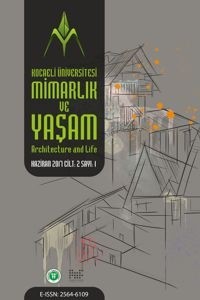Fenomenolojik Yaklaşımın Mimaride Tasarımcı Kimliği ve Malzeme Kullanımı Üzerinden Okunması
Mimarlık, Tasarımcı Kimliği, Malzeme, Algılama, Fenomenolojik Yaklaşım
Handling of the Phenomenological Approach Through Designer Identity and the Use of Materials in Architecture
Architecture, Designer Identity, Material, Perception, Phenomenological Approach,
___
- Armağan, C. Ç. (2011). Fenomenolojik yöntem ve tektonik dil aracılığı ile materyale duyarlı tasarım. (Yüksek lisans tezi) İstanbul Teknik Üniversitesi, Fen Bilimleri Enstitüsü, İstanbul.
- Ayna, A. ve Domaniçli, S. (2011). Duyusal hacim, Mimari Tasarım Eğitimi: Bütünleşme 2. Ulusal Sempozyumu, Yıldız Teknik Üniversitesi, Mimarlık Fakültesi, İstanbul.
- Baudrillard, J. (2016). Tüketim toplumu. (Çev. H. Deliceçaylı ve F. Keskin). İstanbul: Ayrıntı Yayınları.
- Bilgin, İ. (2015). Mimarın soluğu: Peter Zumthor mimarlığı üzerine denemeler. İstanbul: Metis Yayınları.
- Brownlee, D. B., De Long, D.G. ve Scully, V. (1997). Louis I. Kahn: In the realm of architecture. Michigan: Universe Pub.
- Brown, R. ve Farrelly, L. (2012). Materials and interior design. London: Laurence King Publishing Ltd.
- Corbusier, L. (2013). Towards a new architecture. Massachusetts: Courier Corporation. Debord, G. (2016). Gösteri toplumu. (Çev. A. Ekmekçi ve O. Taşkent). İstanbul: Ayrıntı Yayınları.
- Dowling, M. (2005). From Husserl to van Manen: A review of different phenomenological approaches. Nursing Studies. 44(1), 131-142. doi: 10.1016/j.ijnurstu.2005.11.026
- Foster, H. (2011). Sanat-mimarlık kompleksi. (Çev. S. Özaloğlu). İstanbul: İletişim Yayınları.
- Günay, V. D. ve Parsa A. F. (Ed.) (2012). Görsel gösterebilim: İmgenin anlamlandırılması. İstanbul: Es Yayınları.
- Holl, S. (1996). Anchoring. New York: Princeton Architectural Press.
- Holl, S. (2000). Parallax. New York: Princeton Architectural Press.
- Husserl, E. (2020). Fenomenoloji üzerine beş ders. (Çev. H. Tepe). İstanbul: BilgeSu Yayıncılık.
- Karatani, K. (2005). Metafor olarak mimari: Dil, sayı, para. (Çev. B. Yıldırım). İstanbul: Metis Yayınları.
- Kayaduran Akkavak, K. (2017). Mekân tasarımında fenomenolojik yaklaşımlar üzerine bir tartışma. (Yüksek lisans tezi) Hacettepe Üniversitesi, Güzel Sanatlar Enstitüsü, Ankara.
- Kuma, K. (2004). Kengo Kuma: Materials, structures, details by Kengo Kuma. Switzerland: Birkhauser Verlag Gmbh.
- Lash, S. (1994). Reflexivitat und ıhre doppelungen: Stroktur, asthetik und gemeinschaft. Frankfurt: Suhrkamp Verlag.
- Lauter, D. (2018). Architecture with a natural connection, an interview with Kengo Kuma. Modern Painters, 93-101. Blouınartınfo.com, erişim: 16 Eylül 2021, erişim adresi https://search.ebscohost.com/login.aspx?direct=true&site=eds-live&db=asu&AN=132736128
- Leski, K. (2017). Yaratıcılık fırtınası. İstanbul: İnkılap Kitabevi.
- Lewandowska, A. (2019). Reducing architecture to an image. Journal of Education Culture and Society, 10(2), 239-244. doi: 10.15503/jecs20192.239.244
- Levin, D. M. (1993). Modernity and the hegemony of vision. Kalifornia: University of California Press.
- Lewis, M. ve Staehler, T. (2017). Fenomenoloji. (Çev. M. Demirhan, M. B. Gürsoy, O. B. Kaplan, M. Türkan, N. Şahankaya) Ankara: Ayrıntı Basımevi.
- Merleau-Ponty, M. (2017). Algının fenomenolojisi. (Çev. E. Sarıkartal ve E. Hacımuratoğlu) İstanbul: İthaki Yayınları.
- Norberg-Schulz, C. (1982). Genius loci: Towards a phenomenology of architecture. Rizolli Publishers.
- Onur, D. ve Zorlu, T. (2018). Tasarım eğitiminde yaratıcılık olgusu: Çok duyulu farkındalık atölyeleri. İstanbul: Gece Kitaplığı.
- Özçam, I. (2018). Tasarım öğrencilerinin kimlik tanımı oluşturma sürecinde metaforların kullanımı. A. Temizer ve Y.Baytal (Ed.), New Trends in Social Sciences Symposium V Proceedings Book içinde (243-257. ss.), Podgorica: Institut za Geografiju. ISBN: 978-9940-745-02-8
- Öztürk, N. (2014). Malzeme ve inşa süreçlerinin yeniden tasarlanması: Bruder Klaus şapeli ve betonarmenin potansiyeli, Sanat ve Tasarım Dergisi, 1(13), 93-103. doi:https://doi.org/10.18603/std.24311
- Pallasmaa, J. (2019). Tenin gözleri: Mimarlık ve duyular. (Çev. A. U. Kılıç) İstanbul: YEM Yayınevi.
- Pallasmaa, J. (2009). The thinking hand: Existential and embodied wisdom in architecture. UK: John Wiley & Sons.
- Perniola, M. (2005). Estetika XX veka, Svetovi: Novi Sad.
- Spiegelberg, H. (1982). The phenomenological movement. Dordrecht: Martinus Nijhoff.
- Steinmann, M. (1994). Die gegenwartigkeit der dinge. Londra: Artemis Verlag.
- Ulubay, S. ve Önal, F. (2020). Mekân üzerine sorunsallar ve kavrayışlar: Fenomenoloji kuramının yirminci yüzyılın mekân anlayışına etkileri, Megaron Dergisi, 15(4), 606-613. doi: 10.14744/MEGARON.2020.28482
- Upshaw, L. B. (1995). Building brand identity, New York: John Wiley & Sons Inc.
- Ülger, E. (2016). Mimarlık fenomenolojisi ve mekan kavramı üzerine fenomenolojik-hermeneutik bir inceleme: Heidegger mimarlara ne der?, Felsefe dünyası dergisi, (63), 116-154.
- Vasilski, D. (2013). Minimalism in architecture: Materials as an instrument of perception immaterial reality. Arhitektura i Urbanizam. (37), 3-27. doi:10.5937/a-u37-3761
- Yorgancıoğlu, D. (2004). Steven Holl: A translation of phenomenological philosophy into the realm of architecture (Yüksek lisans tezi) Orta Doğu Teknik Üniversitesi, Ankara.
- Zahavi, D. (2020). Fenomenoloji: İlk temeller. (Çev. S. Bayazit) İstanbul: Ayrıntı Yayınları.
- Zumthor, P. (2006). Atmospheres: Architectural environments-surrounding objects, Basel: Birkhäuser GmbH.
- Kengo Kuma Associates. (2021, 16 Eylül). Erişim adresi https://kkaa.co.jp/works/architecture/great-bamboo-wall/ Resim Kaynakları URL-1. https://www.fosterandpartners.com/projects/ (2022, 19 Temmuz).
- URL-2. https://www.architectural-review.com/today/knut-hamsun-centre-by-steven-holl-architects-presteid-hamaroy-island-norway (2022, 19 Temmuz).
- URL-3. https://www.stevenholl.com/projects/knut-hamsun-center (2022, 19 Temmuz).
- URL-4. https://www.archdaily.com/101260/ad-classics-church-of-the-light-tadao-ando (2022, 19 Temmuz).
- URL-5. https://inhabitat.com/tadao-ando-embeds-open-air-prayer-hall-around-massive-15-year-old-buddha-statue/ (2022, 19 Temmuz).
- URL-6. https://www.archdaily.com/106352/bruder-klaus-field-chapel-peter-zumthor (2022, 19 Temmuz).
- URL-7. https://zumthor.org/project/gugalun/ (2022, 19 Temmuz).
- URL-8. https://kkaa.co.jp/works/architecture/adobe-repository-for-buddha-statue/ (2022, 19 Temmuz).
- URL-9. https://archeyes.com/commune-great-bamboo-wall-kengo-kuma-associates/ (2022, 19 Temmuz).
- URL-10. https://www.archdaily.com/924568/new-iconic-museum-for-turkey-by-kengo-kuma-and-associates (2022, 19 Temmuz).
- URL-11. https://inhabitat.com/kengo-kuma-envisions-shapeshifting-nomadic-shelters-woven-from-hundreds-of-identical-wooden-pieces/ (2022, 19 Temmuz).
- URL-12. https://www.dezeen.com/2013/08/27/frac-marseille-by-kengo-kuma/ (2022, 19 Temmuz).
- URL-13. https://travel98.com/article/59402 (2022, 19 Temmuz).
- ISSN: 2564-6109
- Başlangıç: 2016
- Yayıncı: Kocaeli Üniversitesi
Bina Maliyetlerinde Malzeme Etkisinin Han Tümertekin ve Alberto Campo Baeza Yapılarında İncelenmesi
Zübeyde Özlem PARLAK BİÇER, Nur Selcen KARAASLAN
Karadağ Geleneksel Konut Mimarisine Genel Bir Bakış
Armend KANACI, Deniz DEMİRARSLAN, Emine Begüm SAVÇIN
Kent Meydanının Mekânsal Özellikleri ve İyileştirilmesi: Isparta Kent Meydanı Üzerine Bir İnceleme
Şehriban ERASLAN, Ayşe ÇAVDARLI
Yeşil Bina Oluşturma Deneyimi Üzerine Fenomenolojik Bir Araştırma
Tuğba GÖKÇEN, Z. Sevgen PERKER
Tarihi Yapıların Müze Olarak İşlevlendirilmesinin İstanbul’dan Örneklerle İncelenmesi
Fenomenolojik Yaklaşımın Mimaride Tasarımcı Kimliği ve Malzeme Kullanımı Üzerinden Okunması
High-Tech Mimarlığın Geleceğinin Fütüristik Sinema Üzerinden Araştırılması
Beyza Nur KAYAALP, Hilal Tuğba ÖRMECİOĞLU
Canan BEDUR DOĞRUÖZ, İkbal ERBAŞ
Türkiye’de 1930-1950 Yılları Arasında Kadının Toplum ve Konut İçindeki Yeri: Ev-İş Dergisi
